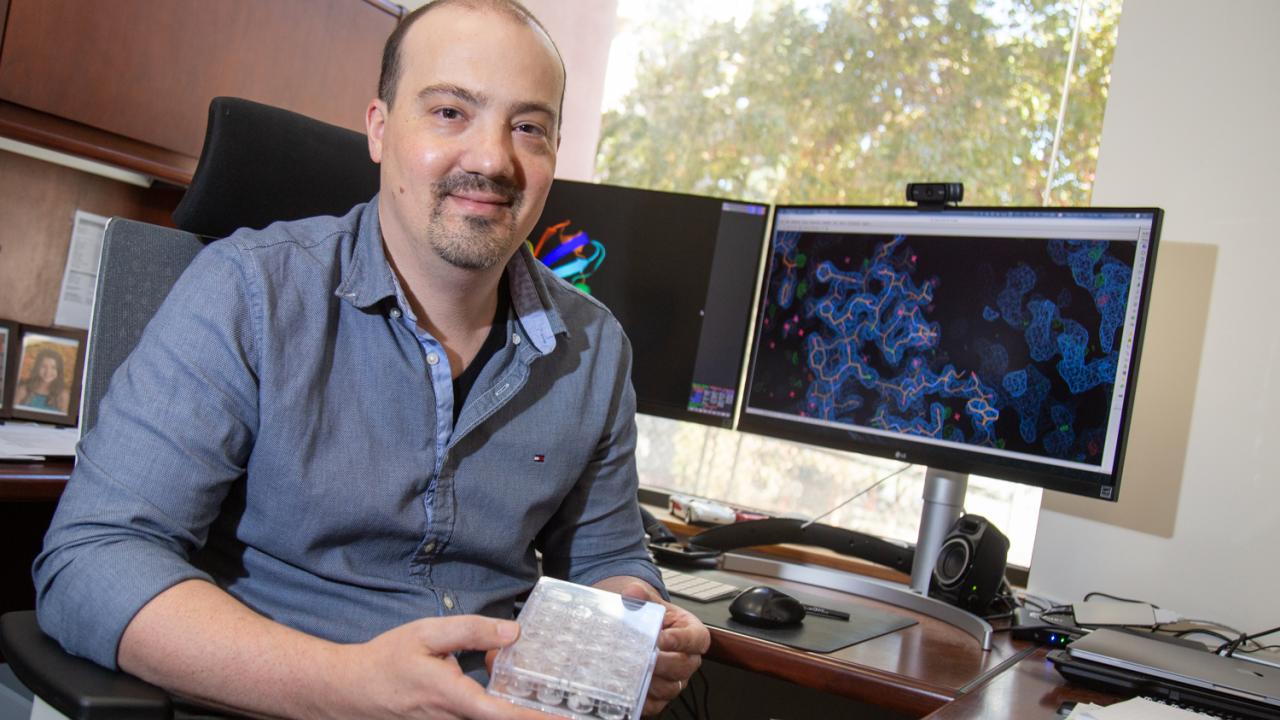
Innovation Award to Help Nitzan Shabek Use Nanoscale Virtual Reality to Find Disease-Fighting Plant Compounds
Quick Summary
- All forms of life have evolved to sense physical and chemical signals like light, temperature, nutrients, oxygen and small molecules
- In the plant world, such biochemistry is survival, with some of these molecules possessing disease-fighting properties
- A UC Davis Award for Innovation and Creative Vision will give Assistant Professor Nitzan Shabek, Department of Plant Biology, the opportunity to expand his cutting-edge research on the chemical world of plant biomolecules integrating virtual reality technology
A $40,000 UC Davis Award for Innovation and Creative Vision will give Assistant Professor Nitzan Shabek, Department of Plant Biology, the opportunity to expand his cutting-edge research on the chemical world of plant biomolecules by integrating virtual reality technology. The research could lead to the development of innovative treatments for disease in both medicine and agriculture.
“I’m so excited and honored to receives this prestigious UC Davis award,” said Shabek. “I am grateful to all my mentors past and present and for the great support from the Dean of the College of Biological Sciences Mark Winey and the Department of Plant Biology.”
All forms of life have evolved to sense physical and chemical signals like light, temperature, nutrients, oxygen and small molecules. Once perceived, cells quickly transform these signals into biochemical responses through the regulation of biomolecule levels.
In the plant world, such biochemistry is survival. From defending against predators and attracting pollinators to ensuring smooth cell functionality, small chemical molecules allow plants to function and interact with the world around them. Some of these molecules have disease-fighting properties but their minuscule size confounds research efforts.
“We want to know how these small molecules can directly affect those critical cellular pathways and can we redirect these metabolites to destroy cancer, neurodegenerative disorders, viruses and other pathogens,” said Shabek. “How can we learn from cellular machines and utilize them to innovate and improve medical and agricultural technologies?”

Shabek’s research focuses on the ubiquitin proteasome system, a cellular machine responsible for the cell cycle, DNA repair, quality control of proteins and signal transduction pathways. Dysfunction of this significant cellular machine can lead to the development of immune diseases, neurodegenerative disorders and cancer, among other conditions.
“In the plant kingdom, this cellular machine is critical for plants to survive and function,” said Shabek. “My lab is interested in understanding these molecular pathways and how they are controlled by the ubiquitin system. Plants are incredibly sophisticated and not only we can learn so much from their biology, we have to research how they adapted to the ever-changing environment. Plants are so critical to our survival on this planet, and our next global crisis is already around the corner. We have to assure food security especially in the face of climate change and crop disease.”
Shabek’s nanoscale virtual reality techniques will allow him and his colleagues to investigate this system and its associated biomolecules in three-dimensional space, illuminating a once hidden world.
“We are working on optimizing this technology to provide a unique drug discovery platform and decipher the molecular basis of signaling pathways,” said Shabek. “With Oculus, we can now dive into the molecular interfaces, physically be there, and use our hands to move a molecule’s coordinates and even design and guide new drugs in a virtual space.”
Shabek also hopes to integrate the technology into the classroom.
“This is a new technological era in which the boundaries between material and immaterial have begun to dissolve,” said Shabek. “Our post-millennial students are very much ready for more innovative concepts in education that can improve learning. Such experiences will have an immediate impact on students and enable them to instantly visualize and comprehend complicated molecular machineries.”
